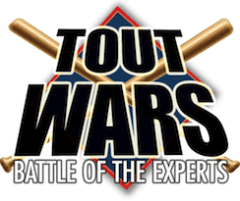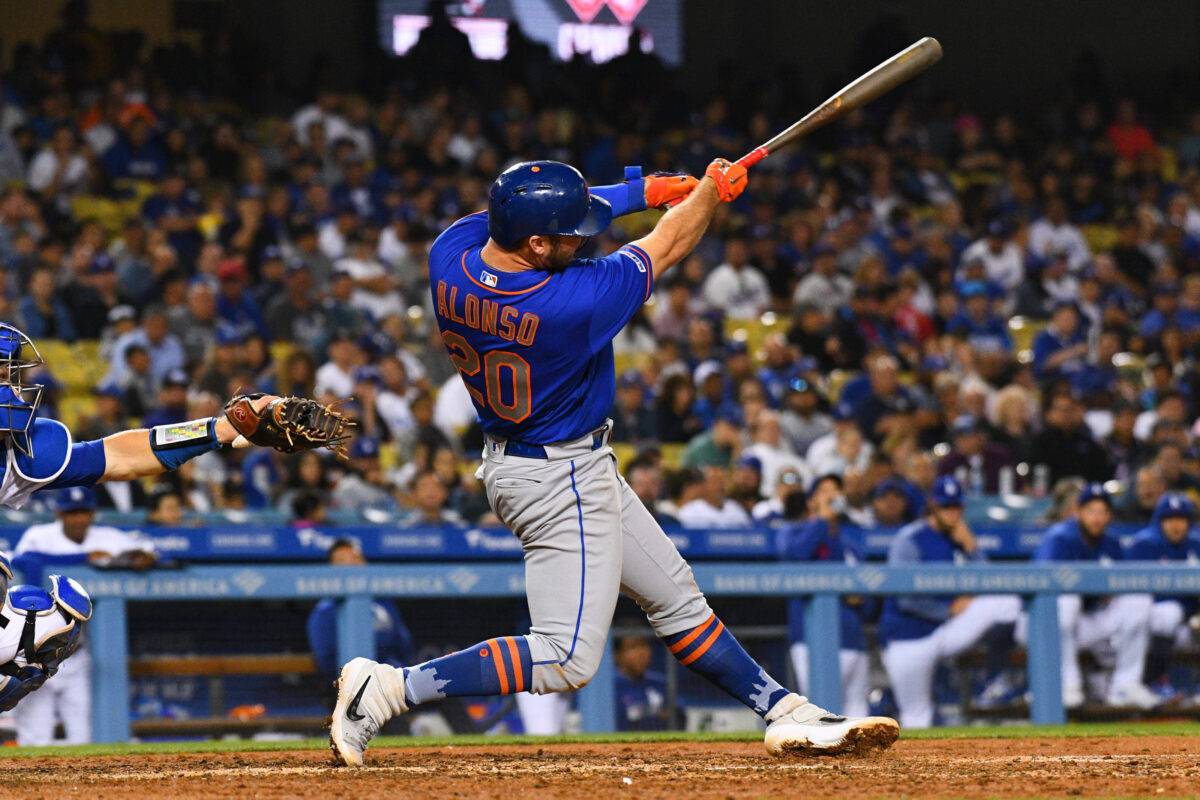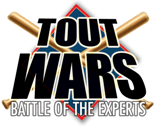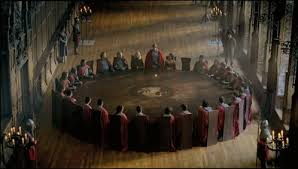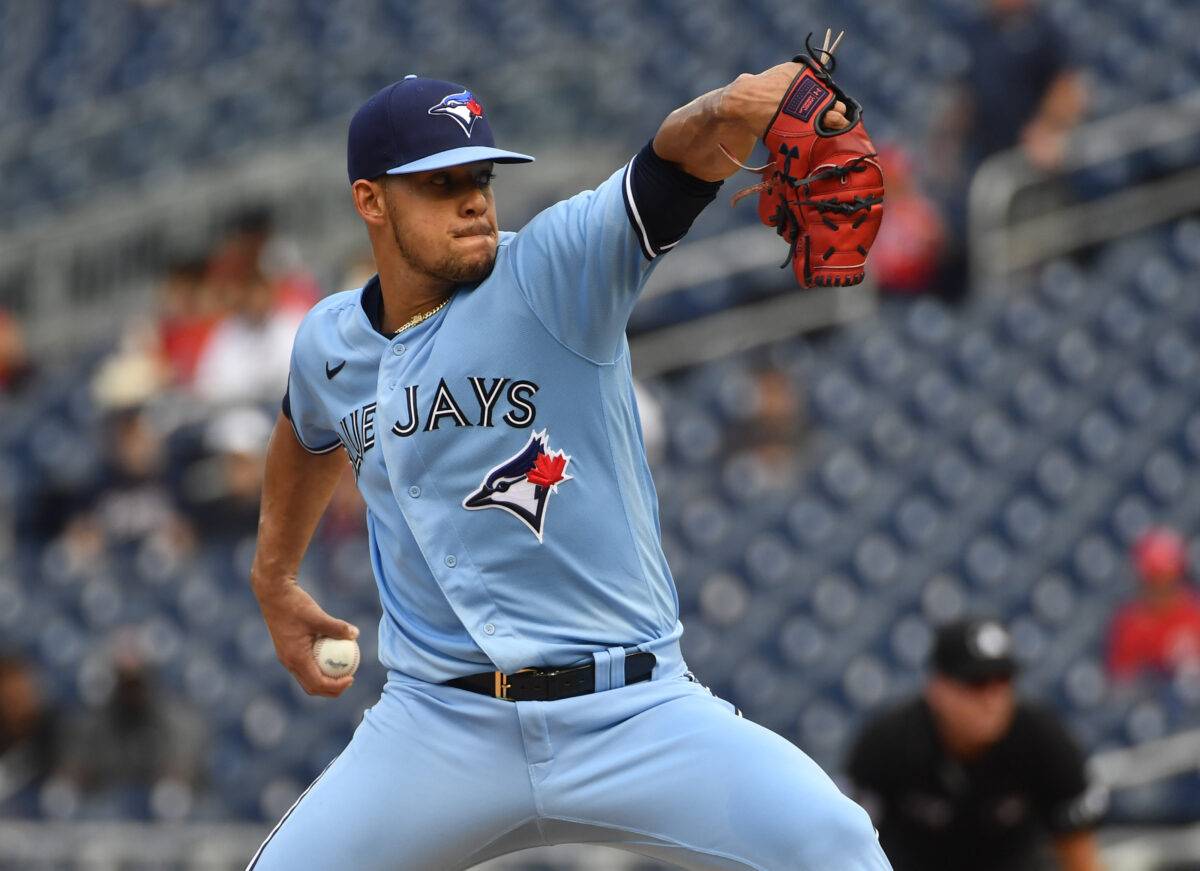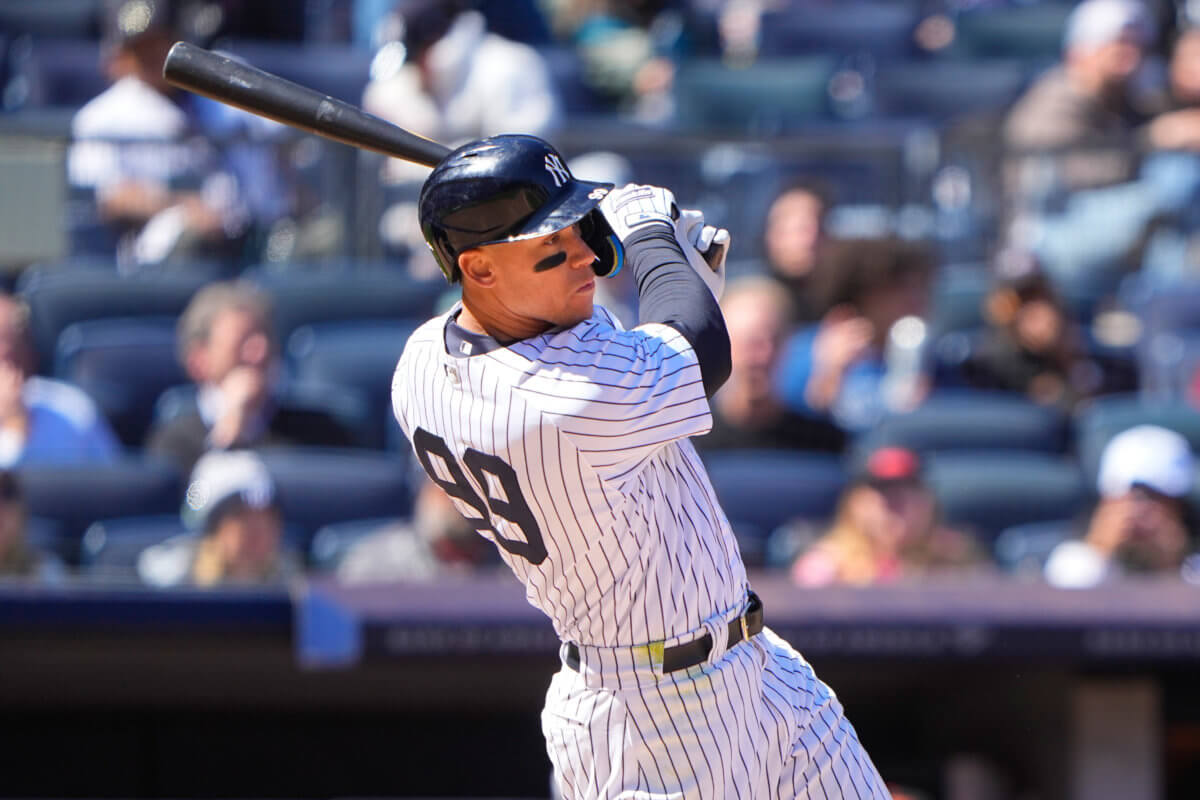We have a first as a trade was consummated in this week’s Tout Table. Unfortunately, it may be the last as one of the participants received some ill timed news soon after finalizing the deal. Who made the trade and who was involved? Read on and find out.
Now that we’re a bit past the one-month mark, how proactive are you seeking trading partners? How do you open the discussions to generate engagement?
Doug Dennis (BaseballHQ, @dougdennis41): Whatever it is that I am doing, it is not working. I typically put a player out there for the others in the league to consider and tell them that if they are interested, let me know and I will work to find a match. Sometimes, this results in a quick match. Other times, there is no match at all and other owners walk away without even a counter–even though they said they were interested in the player. Sometimes, the counter is so obviously an attempt at a ripoff that I know they are searching for found money and hoping that I am desperate to move the player. I think there is no time like now to make a deal, though. You have to have time to impact categories you are targeting and vice versa.
Matt Williams (The Athletic, @MattWi77iams): I am open to a “reply all” open announcement to the league if I happen to have a trade scenario in mind (Trade Player X for an OF), but prefer to do some proactive leg work and find a trade partner who would use the player I wish to move and can afford to move someone I have a need for. It’s not rocket science, but trying to actually create a trade that makes sense for both sides is a step most fantasy managers skip.
D.J. Short (NBC Sports Edge, @djshort): I wouldn’t say I’m proactive; I’m probably more proactive in a dynasty league where it’s easy to spot the managers who are moving in one direction or the other as far as competing. In a redraft league, this is around the time where you might get a feel for what you lack and what you might be willing to part with to upgrade in other areas. Of course, injuries can also play a part in expediting this process. It never hurts to send a quick email to the group or update a trade block in leagues where it can be easily viewable.
Perry Van Hook (Mastersball, @): most of the trading I do is in keeper leagues and if I am initiating trade talks especially for a key player I will send an email to the entire league to let them know that Lucas Giolito (expiring contract) is available
Phil Hertz (BaseballHQ, @prhz50): I look for opportunities to improve my teams from the time trading opens until the time trading closes. Depending on the league, I target particular owners or players or simply send out a blast message. The main function of the one-month mark is to somewhat focus what I’m looking for.
Nando Di Fino (The Athletic, @nandodifino): I send a bunch of trades out to teams and then blast the message board telling them that the first to accept gets the player. I tend to be aggressive if I’m trying to make moves this early. And I’ll make strong offers to show I’m willing to deal and not just putting out feelers. First or nothing! However, all these leagues have quirks: If I’m in a league with Zinkie, I read a well thought-out several-paragraph-long email about why I need this player to move up three points in steals, then accept it, hypnotized. I’m in a league with Pianowski, I reply with “I like the offer, but how about this” and he’ll reply with “I like that offer but how about this?” and we usually get it done in record time.
Howard Bender (Fantasy Alarm, @RotobuzzGuy): I am actively throwing trade offers at everyone in the league right now regardless of needs or standings. I consider the first offer to be the first step in a negotiation so I usually make really crappy offers and hope someone mistakenly bites on one. If they don’t then I just keep sending the ol’ “pile-o-junk” quantity for quality trade, hoping they will just caves in to my unrealistic demands. Oh wait….that’s the blueprint for never being my trade partner in the future. I’m not sure I understood the assignment.
Ariel Cohen (CBS Sports, @ATCNY): Great timing on the question. In LABR, I just completed a trade with Matt Williams. For this, I had an underperforming Jesse Winker on my bench, and needed a bit of pitching help. I sent an e-mail out to the entire league asking for a pitcher in return for him. I got a couple of offers, and ended up working with Matt on a simple 1 for 1 trade. I traded him for Eduardo Rodriguez, another underperforming player. It is usually at this time of the season (1 month into it) where I assess my team categories, and look at my strengths/weaknesses. Rather than a “Trade Block” approach, I typically than engage teams in each league who may be good trade partners. I get the conversation going on what I am looking for and can offer.
Alex Fast (Pitcher List, @AlexFast8): I usually am not the first person to trade but with all these under-performing players, its difficult not to. For this year, I’d be looking to trade for pitchers like Woodruff or Morton (or other underperformers who I feel confident will turn it around) for a high level struggling hitter. This is only if I feel confident that the pieces that I have that are currently performing are sufficient. Usually though, I’m holding tight.
Rob Leibowitz (Rotoheaven, @rob_leibowitz): This is just the point of the season where I do start to assess my team’s strengths and weaknesses now that some of the stats have built up and gaps in the standings have occurred. I am starting to identify potential trade partners, but don’t yet feel a need to initiate an offer as no category wherein I have a lead is substantial enough to not be completely undone by the absence of those strong players and/or the trades of other teams. I prefer to engage specific owners rather than broadcast my intentions and when I make larger moves or moves to try and have multiple potential trades lined up to try to create a domino effect as I try to move up the standings in key areas at once to offset any potential losses. I find the best initial offers cut to the chase, offering up multiple options to the team you want a player from such as “one from column A, two from column B”, etc. I loathe emails of the “Do you have any interest in X player or are you willing to trade “x” player?” Initiators should always make an offer if they expect to accomplish anything. In Dynasty leagues, teams are already considering dumping, so you have to be much more aggressive to target long-term keepers for the dumping team and the pivotal non-keepers for a championship-bound team.
Rudy Gamble (Razzball, @RudyGamble): I only play redraft and only two of my leagues allow trades. If my team is particularly imbalanced, I look for teams that are the opposite and look for a win-win trade. I will send an all team e-mail in the few cases where my team is just loaded with solid players and I’m facing a roster crunch.
Brad Johnson (Baseball HQ, @BaseballATeam): Like many others here, I’ve grown accustomed to using trade blocks rather than proactively seeking out players. Mostly, I trade with the waiver wire. I have an addiction to fringe players so I’m usually happier to grab a Travis Demeritte for free than to work on big trades. In dynasty leagues, I tend to develop my trades over multiple months.
Fred Zinkie (Yahoo! Fantasy Sports, @FredZinkieMLB): I’m in draft and hold this year, so no one has the misfortune of having to talk trade with me LOL. But when I want to make a deal, I want to start with a specific offer that accomplishes two things: it shows the other owner that I put some thought into why they would want to make the deal, and it gives them some flexibility to swap out names that they don’t want to be involved.
Mike Podhorzer (Fangraphs, @MikePodhorzer): Unfortunately, I’m quite lazy when it comes to seeking out trading partners. That laziness, combined with my excruciating patience, means I don’t generally send out many trade offers. If I do muster the energy to initiate talks, it’s vital that you seek a partner who actually needs the position and/or category you’re looking to trade away. Just as I get annoyed when I get offered a player who is worse than the players currently starting for me and would therefore just sit on my bench, your trading partner isn’t going to accept an offer unless it clearly benefits his team and fills a hole or weakness.
Patrick Davitt (BaseballHQ, @patrickdavitt): I agree with Doug’s observation that now is a great time to make a trade because there’s loads o’ time to get the positive effects. The problem is that it’s also usually too soon to see where your surpluses or unrecoverable shortfalls are going to be, and projections are notoriously inaccurate. In my only trading league, the standings are still highly volatile and almost literally anything could still happen—I could make up ground or get kicked right in the decimals. As it happens, I have a pretty solid lead in SBs in my trading league, and I’ve been looking at potential trade partners who might benefit from SBs, but I’m not sure they’ll be willing to deal a multi-cat contributor for a guy whose value is mostly or entirely in bags. I’ll be figuring out what to do this week.
Michael A. Stein (Fantasy Judgment, @FantasyJudgment): This is an appropriate time for me to see where I need to improve and seek out trade partners. I am very conservative with trades so it is rare for me to pull off deals, even though I did make a blockbuster already in a redraft league where I was able to sell off Semien in a package and get back Bichette before he got hot. I like to have depth on my rosters, so I usually try and trade from areas of strength in order to improve at a specific position or in a particular category. Having over a month’s worth of stats is a fair gauge of a player’s value, but such an evaluation needs to be looked at in context with what MLB is today. If I see another team with needs that I can address through my own depth and flexibility, then I will make an overture and see if I can pilfer someone from them to improve my team. But usually I wait to be approached by others before engaging in negotiations depending on the type of league it is.
Sara Sanchez (bleedcubbieblue.com, @BCB_Sara): Great timing on this question since it’s right at the time of the season when I start to assess whether I’m looking to flip some players for others. I look at standings to see if there is a potential match based on player performance and areas of strength. When I find a match, I make an offer. I tend to send out fewer offers than other managers I’ve played with and as a result I try to keep that initial offer competitive for both of us. If the other party isn’t interested I’ll move to my next best bet.
Tim McLeod (Prospect361.com, @RunTMcP361 ): It’s still early. I initiate very little trade talk until the end of May. I try to exercise a fair bit of patience and use the Free Agent pool to improve my team early-on, giving under-performing players an opportunity to right the ship. Once we head into June the gloves come off and the search to find a match that makes any deal a win/win for both parties begins.
Eric Karabell (ESPN, @karabelleric): I haven’t been so aggressive in initiating trade talks in recent seasons, but I also like to exorcise patience and allow proven players ample time to get their numbers. Sometimes one can just tell someone is not going to work out, though. I know I don’t like when another team offers me a clearly one-sided deal, so I don’t do it either. I admit I’m more likely to initiate a trade with another manager I know better.
Charlie Wiegert (CDM Sports, @GFFantasySports): The Godfather always like to make an offer that can’t be refused, but I haven’t sent any offers out yet this year. There are a few players that have gotten off to slow starts that I have an interest in, so it’s time to either make a play for them or move on. I’m not suffering in any categories bad enough that I feel a major need, so I’m might just stay quiet for another month.
Dr. Roto (FullTime Fantasy, @DrRoto): While I am always looking for potential deals and trade partners, I rarely make any offers prior to the end of May as I know that most other teams prefer to wait until then. That said, when the time comes, I always try to make an offer that can help a competitor otherwise the offer is a waste of time and they might be reluctant to deal with me in the future.
Andy Behrens (Yahoo! Fantasy Sports, @andybehrens): I’m so proactive that I’m willing to do it right here in Tout Table. Sara: I think you should trade one of those aces to me for Seiya or Yordan or some other piece. It seems like we should be able to work out a hitting-for-pitching swap, given our various team needs. Let’s get this done right here in the shared Google doc.
Mike Sheets (ESPN, @MikeASheets): I’m always open to deal. If I have a weakness, I’d rather address it now than wait another month or two, when I might be in a bigger hole. Maybe six weeks isn’t enough to give us the full picture behind a player’s success/struggles, but we have at least some data to work with. Plus, I’ll admit that, for me, trading is part of the fun. I don’t trade just to trade, but I’m not afraid to pull the trigger if I think a deal will help me, even if it’s early in the season.
Eric Cross (Fantrax, @EricCross04): Having a discussion with the potential trade partner before actually making an offer can be highly beneficial. Blindly sending offers back and forth rarely works so having that discussion about what you’re looking for, what they are looking for, etc. is the best way to try to get something done in my opinion.
Greg Jewett (Fantasy Alarm, @gjewett9): Identify my team needs, then a team in the league who can address it, and who I can help in the trade as well. Even if I “lose” the trade on perceived perception, if it upgrades the roster giving me the best chance at gaining on the league, it’s worth it. Do not be the person sending out a three-for-one deal to everyone in the league.
Sara Sanchez (bleedcubbieblue.com, @BCB_Sara): Andy: I’d definitely be interested in adding more bats. Probably more likely to deal Kershaw, what are you willing to part with for Clayton?
Andy Behrens (Yahoo! Fantasy Sports, @andybehrens): *Unrolls cartoonishly long list* I probably won’t trade runaway N.L. MVP fave Juan Yepez, but almost anyone else is in play. I have the same reservations as anyone else would with Kershaw, mostly related to durability. And yet I also need to do something about my ratios before they calcify. If we were drafting from scratch today, I’d probably rank Kershaw in the neighborhood of … Bregman? Abreu? I’d deal either of those two.
Sara Sanchez (bleedcubbieblue.com, @BCB_Sara): Bregman for Kershaw rest of season looks like a fair deal to me, I am actually more in need of outfielders if you were willing to part with Seiya for Kershaw.
Vlad Sedler (Fantasy Guru, @rotogut): We should always be in the mode of trying to improve our rosters and trying to ‘take advantage’ of league-mates who might be overreacting to slow performers. It’s important to stay in contact with folks in your league to gauge their temperatures on hitters or pitchers of theirs who could be great trade targets for you. By keeping in occasional contact, you appear less suspicious than if you just contact them out of the blue with a trade proposal. A friendly ‘face’ is one others will be more willing to do business with.
Andy Behrens (Yahoo! Fantasy Sports, @andybehrens): I still don’t know how the rest of the world values Seiya, because I was too high on him to ever let anyone else draft him. I would deal Seiya for Kershaw, given my pitching situation. Let’s do this thing.
Sara Sanchez (bleedcubbieblue.com, @BCB_Sara): Done, send me the deal 🙂
Justin Mason (Friends with Fantasy Benefits, Fangraphs, Fantasy Alarm, @JustinMasonFWFB): I try to always be active on the trade market. I aim to find out what my partner is looking for so that way we can both walk away happy. Trading is like a relationship, if you screw your partner over too many times, you’ll find yourself all alone.
Jeff Boggis (Fantasy Football Empire, @JeffBoggis): If I find that I have a void in my team roster, I will be the one to initiate “the art of the deal”. Once I find the players that I am targeting, I will look at my trading partner’s team to see where he needs help and if I can help them. I really dislike receiving trade offers where there is no benefit or incentive for me to negotiate a trade. People need to listen to the following FM radio station which is “WIIFM”, which stands for What’s In It For Me?
Brad Johnson (Patreon/BaseballATeam, @BaseballATeam): I’ll add, I’ve grown absolutely exhausted with folks saying “you didn’t consider my needs.” Consider your own damned needs. I’d say maybe 1 in 200 offers I get makes a lick of sense for my team. I’ll look out for myself. You look out for you. We’ll find a fit if there is one.
Joe Sheehan (The Joe Sheehan Baseball Newsletter, @joe_sheehan): I am certainly more passive than average, I think. I spend a lot of time looking at the standings and rosters for matches, but will tend to sit back and be prepared for offers more than I’ll propose them. When I do, though, I am aggressively transparent, especially in industry leagues, where it’s safe to assume you’re not going to rook anyone, and the process of making a deal can generate writing ideas. So you should explain your thinking up front and look hard for win-win deals.
Chris Towers (CBS Fantasy Sports, @CTowersCBS): I tend to not be as aggressive as I probably should be with trade offers at this time of year because I’m still trying to figure out what my team actually needs. Sure, I can just look at the standings, but if I have faith in my hitters, do I necessarily need to make a trade for one just because I’m struggling right now? Admittedly, this is also why I might be a bit too slow to react to in-season changes, but I’m finding it especially hard to make big moves right now because I just don’t quite have a grasp on how the new offensive environment is going to play when the weather warms up. I’ll probably be more willing to go search out deals in the next few weeks.
Andy Behrens (Yahoo! Fantasy Sports, @andybehrens): Let the record show that Kershaw hit the injured list WITHIN 24 HOURS of our trade, Sara. Definitely the last time I agree to a deal in a Google doc.
Zach Steinhorn (CreativeSports2, @zachsteinhorn): A brief note on the league message board in which I state my position/category needs along with what I have to offer is my first step, but I’ll also look at the category standings and many of the rosters to see if I can find a fit. I usually won’t get player-specific until I communicate directly with a certain owner. Maybe they have interest in a player I thought no one had interest in, so it is best not to limit yourself by immediately naming a few players who are available. Sometimes, I will receive a response to my message board post and a trade could get worked out but I’ve actually had more success sending e-mails to specific owners. It shows that I put in the work to not only think about my own needs but also their potential needs, and if there’s a deal to be made, the negotiations tend to run very smoothly.
Jason Collette (Rotowire, @jasoncollette): I find myself more willing to receive offers than give them. I’m always open to listening to ideas, but get frustrated when I do reach out to initiate trades and the other party slow plays things or just never replies. I am not a fan of blind email offers, but I also feel If I’m putting too much explanation into the offer, nothing is going to happen. I have a few trade league teams with some imbalances, but have thus far been unable to find willing trade partners.
Todd Zola (Mastersball, @toddzola): I’ve heard trades negotiated and consummated on the radio, but not here. Pretty cool. Anyway, I’m not much for being proactive with deals, especially early, but I do want to present myself as approachable and congenial in negotiations. As such, I try to agree to an early swap, even if I see it as a parallel deal on my end. That is, I don’t improve nor hurt my team, but others in the league see I made a deal, so they may be more incentivized to get in touch.
Scott Swanay (FantasyBaseballSherpa, @fantasy_sherpa): I’ll probably be even slower than usual this year to dip my toes in the trade waters – between the dead ball (or not), the impact of the humidor (or not), it’s tougher than usual to get a feel for which players’ slow/fast starts are legit vs small sample size aberrations. A set any categorical or roster imbalances attributable to injuries or demotions, I don’t feel I have enough information yet to assess most players at this point.
